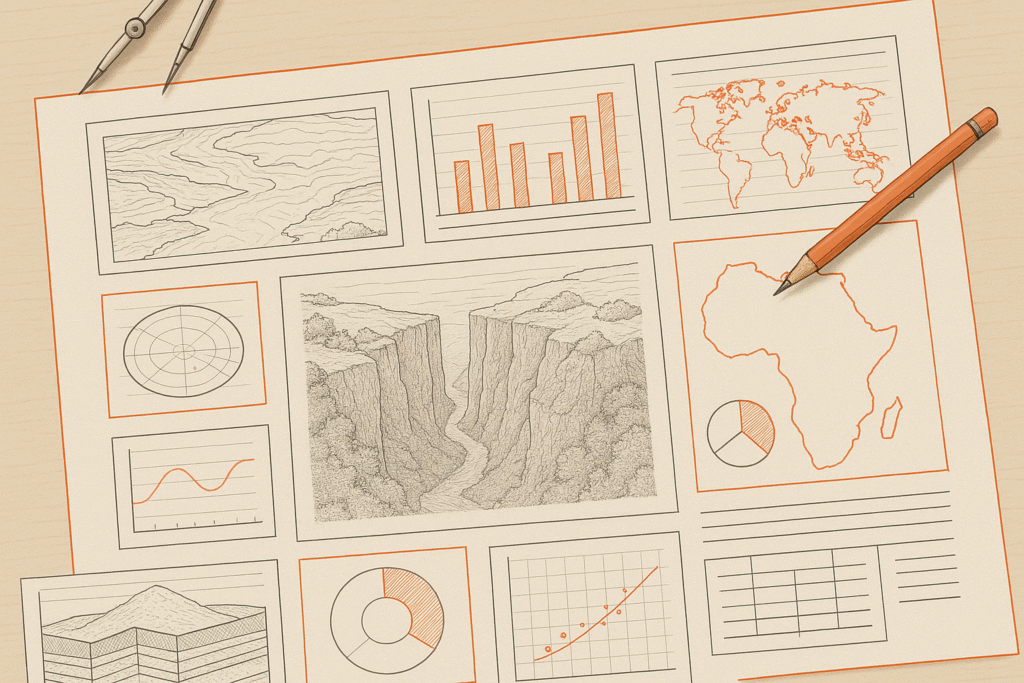If you’re feeling unsure about Paper 1, you’re not alone. It’s one of the first IBDP Geography exams students face, and it can feel like a lot to juggle. But with the right strategies—and a few insider tips—you can walk into it with clarity and confidence.
Let’s break it down.
📘 Official Name & Exam Format – Paper 1: Geographic Themes
- Duration: 1 hour 30 minutes (SL) / 2 hours 15 minutes (HL)
- Weighting:
- SL: 35% of your final grade
- HL: 35% of your final grade
- SL: 35% of your final grade
This is the paper where you answer structured and extended-response questions based on the Options your school has chosen to teach.
🌍 The Options – A to G
There are seven themes to choose from. Your school will usually cover two (SL) or three (HL).
| Option | Theme |
| A | Freshwater |
| B | Oceans and Coastal Margins |
| C | Extreme Environments |
| D | Geophysical Hazards |
| E | Leisure, Tourism and Sport |
| F | Food and Health |
| G | Urban Environments |
Most popular combinations?
From what I see, many schools choose all Human Geography options, especially:
- F: Food and Health
- E: Leisure, Tourism and Sport
- G: Urban Environments
Why? Because physical geography units like A, B, and D can be vocab-heavy—tricky for EAL students.
That said, I strongly recommend including Freshwater (Option A) if you can. It’s fascinating, connects beautifully to other units like Climate Change (Unit 2) and Resource Consumption (Unit 3), and even helps with Paper 3 if you’re HL.
🧠 Structure of the Exam
Each Option has two questions.
Each question contains:
- Three short-answer questions (usually worth 1–4 marks each)
- One 10-mark essay-style question
You choose ONE question per Option studied.
So that means:
- SL students answer two full questions (from two Options)
- HL students answer three full questions (from three Options)
📝 Example Questions
Here’s what the questions can look like:
From Option F: Food and Health
(b) Suggest one reason for food insecurity in a named region. (2)
(c) Explain how national strategies can help reduce food insecurity. (4)
(d) “Health patterns are more influenced by wealth than by location.” Discuss. (10)
From Option E: Leisure, Tourism and Sport
(b) Outline one environmental impact of mass tourism. (2)
(c) Explain how political factors influence participation in international sport. (4)
(d) “Leisure inequality is more about gender than income.” Discuss. (10)
Notice how the essay questions are often phrased as a statement to evaluate.
That’s your cue: balance your response, show multiple perspectives, and back it up with examples.
⏰ Time Management Tips
This is one of the biggest challenges students face.
Per Option, I recommend:
- 15–20 mins: Short-answer questions (don’t rush, but don’t over-write)
- 5 mins: Planning your essay (yes—plan it!)
- 20–25 mins: Writing the essay
If you’re HL and answering three Options, that time structure becomes even more important.
Use your reading time wisely:
- Read all the questions for your Options.
- Pick the ones you’re most confident with.
- Start thinking about case studies and definitions as you read.
- Don’t panic if one question looks weird—you’ve got a choice.
🤯 Common Struggles
Let’s be real about what students often get wrong:
- Wasting time on overly long SAQs or perfecting the intro
- Forgetting to link back to the question (especially on longer SAQs)
- Skipping the essay planning
- Waffling in the 10-mark response
- Lack of place-specific examples
- Trying to answer a question from a topic you haven’t studied 🤦
That last one seems obvious, but I’ve seen it happen. Just don’t. You don’t know what you don’t know.
💡 Essay Advice: HO(P)PED to Success
Use this structure to nail the 10-mark question:
Introduction – HO(P)PED
- Hook (a fact, stat, quote, or big opinion)
- Opinion (what you think)
- Perspectives (stakeholders)
- Place-specific example
- Examples (support your view)
- Definitions (key terms in the question)
Body Paragraphs
- Link each paragraph back to the question
- Use evidence and explanation—don’t just list!
- Bring in multiple perspectives (economic, social, political, environmental)
- Consider scale (local vs national vs global)
- Include examples from LICs and HICs where relevant
- Always evaluate
Conclusion
- No new info!
- Reaffirm your opinion, summarise key perspectives and evidence.
And remember: structure matters. Neat, clear, and easy to follow wins the examiner’s heart (and their marks).
Want more on this? Look out for my blogs on:
- How to Write a Top-Quality 10-Mark Essay – How to Write a Top 10-mark IBDP Geography Essay for Paper 1 and Paper 2
- How to Write a Killer 10-Mark Essay Introduction
🔍 Common Myths – Busted
- ❌ “You need to write loads to get a 10”
➤ Nope. Quality over quantity. Be focused, not flowery. - ❌ “The essay’s more important than the SAQs”
➤ Not true. Those SAQs add up—don’t skip them or rush them. - ❌ “If I write vaguely, the examiner will get what I mean”
➤ Examiners can’t give marks for guesses. Be precise. Define your terms. Use examples. - ❌ “Planning is a waste of time”
➤ Honestly, planning saves you time—and raises your mark. Every. Single. Time.
✅ Final Tips
- Answer the SAQs first—they’re quicker marks.
If you run out of time for the essay, aim for at least 5–6 marks. - Use the command words: Explain, Suggest, Discuss, Evaluate—they all mean different things.
- Include specific places, examples, and named strategies.
- Don’t rely on generic statements like “this is good for the economy.” Be specific and critical.
- Stay calm and think like a geographer: patterns, processes, perspectives.
🚀 Ready to Master the Rest?
You’re halfway there.
👉 Read the rest of my IBDP Paper Series:
- Paper 2 – How to Tackle the Core Exam
- Paper 3 – HL Extension Made Simple
📺 Check out my YouTube channel for clear, fast Geography tips that actually make sense.
💬 Need help with a topic or just want to practise a 10-marker together?
Book a free 30-minute session with me—tailored support to help you boost your confidence and your grade.



